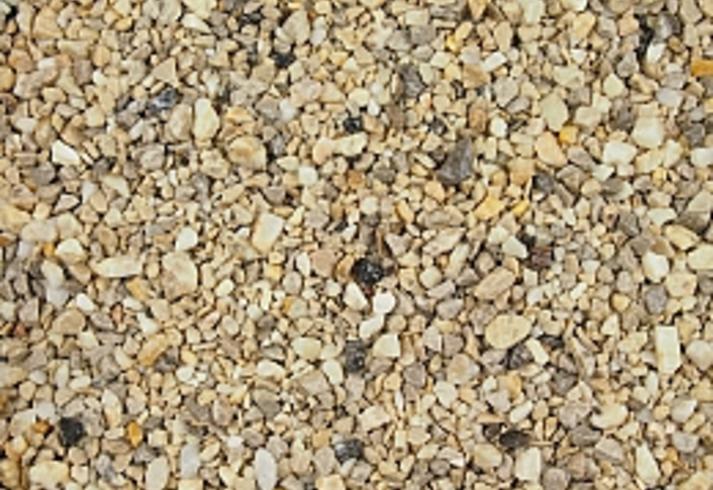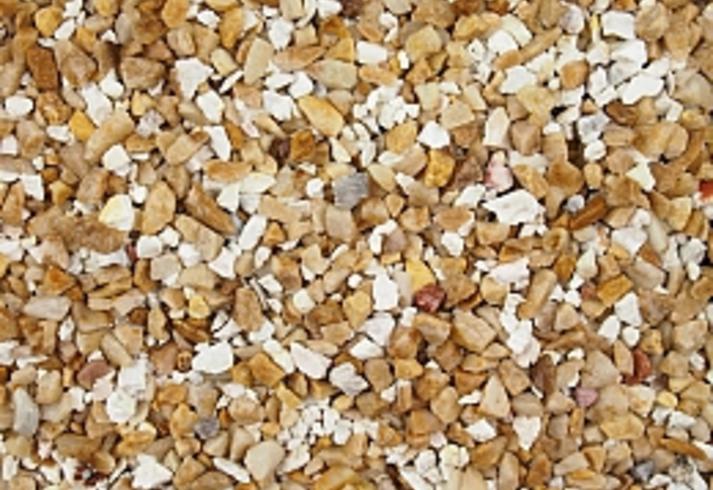Rendering Defects - What Can Go Wrong?
Iron Staining
Iron staining is a natural problem that can occur when specific individual stones within the product that have high iron content are used for dry-dashing are exposed to the environment. This problem is often increased if the site is in an exposed or coastal region. It is not unusual for the problem to take a number of years to be exposed and there is no way of identifying if the aggregate is affected prior to application.
It is not possible to screen the iron content out of the product by using magnets as it is part of the chemical makeup of the aggregate. The aggregates affected by this problem are mostly flint or gravel based type products or aggregates that have usually been quarried from glacial or river deposits. Using Calcined Flint aggregates will not eliminate this problem if the raw flint used already has a high iron content.
Iron staining is a natural occurrence, and no guarantee can be given or liability accepted for areas affected by iron staining. Derbyshire Specialist Aggregates only select aggregates from quarries that have proven records of low iron content, but should it be required that a zero risk of staining is required we can recommend a number of products that have no history of staining over the last twenty years. Products that may contain iron traces are marked on our product page. Advice can be given as to the best course of action required to treat any problematic areas. Whilst iron staining can cosmetically spoil the appearance of the affected areas it has no detrimental effect on the render itself.
Uneven Appearance and Irregularity of Surface Texture
Uneven trowelling and application of chippings can cause patchy appearance on walls. The absence of a suitable waterproofing agent can lead to marked differences in suction resulting in difficulties in embedding the chippings evenly to the mortar. This results in the chippings being more pronounced in some areas that others resulting in irregular overall appearance. Unless both the mortar and the chippings are applied evenly to the wall and with the same intensity, the wall appearance will be irregular. Care should be taken to obtain a wide and even spread in order to distribute the aggregate and give a uniform appearance.
Temporary Protection of Dashed Elevations
When scaffold is used to apply dashing aggregates in poor or exposed weather conditions temporary protection of the elevation should be used. Driven rainwater can bounce or be deflected onto the dashed area creating scaffold lift lines on the wall that are often not seen until the scaffold is removed. Sheeting off the elevation can prevent this as it is not possible to rectify this problem without replacing the entire affected area. Consideration should be given to scaffold protection prior to any work commencing on site and ideally at the tender stage of any scheme. Bear in mind that other parts of the building may require protection from the render application, particularly if cement polymers are included in the mixes.
Rendering Defects – What Can Go Wrong?
Bad Materials:
Wrong grade or contaminated sand used.
Substandard or 'dead' cement caused by careless storage or handling.
Not up to standard lime used.
The use of non suitable or unproven additives.
Dirty or contaminated aggregates.
Bad Mixing:
Poor, inadequate or unservicable plant/mixers.
Careless proportions of materials in batching. Over mixing allowing the introduction of too much air into the mortar.
Incorrect use of plasticer and waterprooder by simply not following manufactures guidelines.
Bad Substrates:
Unprepared surface, no mechanical key.
To high sorptivity (sunction)
Chemical contamination
Bad Application:
Unskilled labour Used
Skimping on render thickness
Inadequate keying of coats.
Curing time to short between coats.
Lack of wetting down.
Weather
Prevailing weather conditions ignored – too hot or too cold or too wet.
Bad Design:
Poor detailing generally, no overhangs, no DPC's where required, raw edges exposed.
Movement joints that are inadequate or badly positioned too may beads used.
Poor specification, lack of thought, bad descriptions, wrong information and technically irrelevant.
The following examples are for guidance only and are based on a wide experience of defective render surfaces.
Heavy spalling of all render coats, exposing bare substrate, with flush joints with more than 20% already off or coming off. Look for extensive random crazing, moss growth in fissures (small hairline cracks), poor key, bad sub-straight, insufficient thickness of render coats, bad detailing. Usual causes are frost attack due to poor weather resistance with water getting behind render. Chemical attack affecting sub-straight.
Light spalling is caused by the same issue above but tends to be more localised and affecting less than 20% of the elevation. Look for localised cracking, structural movement or impact damage near to the defect area. Look for signs of previous repair and any bad detailing around the fault. Usual causes are frost attack on an over wet area such as a running overflow. Bad sub-straight such as different materials in back ground. Chemical attach.
Delaminating. One coat from another leaving a lightly keyed or un-keyed surface. Usual causes are poor mechanical key such as first coat not properly scratched, or too rapid dehydration of top coat that can be because the first coat had sorptivity that was too high through lack of waterproofer or wetting down. Top coat was a stronger mix than base coat.
Heavy Cracking. Cracks that are over 1mm wide, often around openings, sometimes reflecting brick or block pattern. Look for settlement or structural cracking, shrinkage cracking in brick or block base. (Could be uncured material not fully shrunk or dried.) Different materials used in background such as brick, block, concrete, steel or timber. Heavy cracking is not usually confined to the rendering and normally reflects the substrate.
Light Cracking or fissuring. Less than 1mm wide. Look for random pattern of cracks often around door or window apertures. Examine all surfaces carefully and methodically. Look for tell-tail signs such as moss growth in cracks due to water being retained along with dirt in cracks. This problem is usually more obvious after rain when surface is drying out. Usually caused by base coat not fully shrinking prior to top coat application. Wrong materials such as sand with too high a shrinkage co-efficiency. Material used is too fine. Drying out was too rapid due to hot weather or the top coat was not weak enough with too much cement.
Balding. This issue applies to dry- dashed buildings. With a loose of surface texture or dashing aggregate leaving bald or pitted areas. Check the shape of the aggregate used. More angular aggregates key into the render better than rounded products. Can be caused by severe exposure to weather, particularly wind and usually affects older render. If the top coat used was too weak this will affect the bond with the aggregate.
Friable Surface. Render coat or dashing aggregate easily rubbed away by hand over sizable areas. Usual causes are too weak a top coat, old age of render. Too rapid dehydration (lack of water proofer in the scratch coat) inadequate wetting down. Weather to hot during application or coat exposed to frost before curing. Miss-use of plasticiser or over mixing with too much air entrapment.
Wrinkled Surface. Look for 'fluid' effect on rendering, wrinkled or slumped surface. Can be caused by using too soft a mix when applied or dry-dashing too soon after top coat is applied.
Lift Marks. Look for marks at scaffold board levels that are often only viable when the scaffolding is removed. Usual causes are a lack of care in forming joint in work being carried out on two levels. On dry-dashing the texture can appear different due to the application being done both upwards and downwards causing a build-up of aggregate. Dirt or water mark caused by rain splashing off a dirty scaffold board on to new rendering.
Scud or whip marks. Fan marks mainly in wet dashing caused by poor application.
Bleaching or Patching. Gradual paling of coloured mortar finishes in isolated spots or all over surface. Usually caused by inferior pigments, lime bloom or rain damage before the render has set. Badly proportioned or badly mixed mortar or dirty water used in mix. Can also be caused by not using render from the same batch or not blending dry-dashing aggregate bags together prior to application such as dashing straight from bag. This can also create problems when aggregates of smaller or larger sizes are concentrated in one area as they have not been blended prior to application or dirty aggregates are used.
Rust Staining. Although already covered in detail iron staining can also be caused by using inferior beads that can rust if exposed to elements. Internal plaster beads incorrectly used externally will create this problem.
Contact us on 01629 636500 for any help or technical advice or Contact Us or email sales@derbyaggs.com



















